A: Thanks for this question! I want to begin by reminding all of us that in yoga circles “hip opening” sometimes gets reduced to the combination of hip flexion, abduction and external rotation of the femur bone (thigh bone) in the hip socket, as in Cobbler’s pose (Baddha Konasana) and Lotus pose (Padmasana). But the hip obviously moves in many other directions, so “hip opening” should reflect the improvement of the full range of motion of the hip joint! So, in general, for yourself and your students, focus on good overall hip opening, which will have positive impacts on posture, locomotion, balance, and agility.
Opening the Front of the Hip Joint
To open the front of the joint—the area your sedentary and seated students need mostly—you want to stretch the front thigh muscles, such as the quads and the psoas by extended the joint, so High Lunge (Vanarasana), including the classic and chair versions, and the Dropped-Knee Lunge, and Warrior 1 (Virabradrasana 1) for the back leg can effectively work those areas.
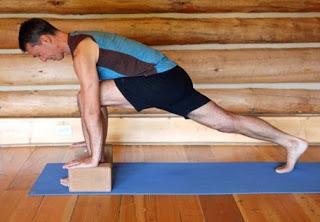
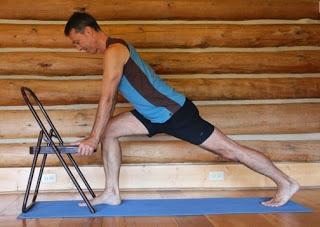
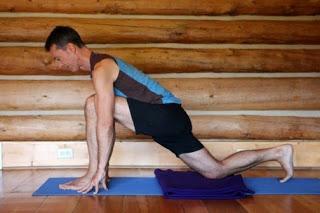
Opening the Inner Hip Joint
To open the inner aspect of the joint, you want to lengthen the adductor group of muscles via poses that take your legs wide apart, such as Standing Wide-Legged Forward Bend (Prasarita Padottanasana), Pyramid pose (Parsvottanasana), Triangle pose (Trikonasana) and Extended Side Angle pose (Utthita Parsvakonasana), and Wide-Angle Seated pose (Upavista Konasana).
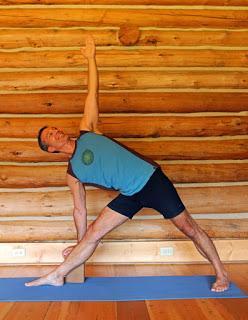 Opening the Outer Hip Joint
Opening the Outer Hip Joint To open the outer hip joint, you want to adduct the hip joint via poses that bring your leg across the midline of your body. You can do this movement with Reclined Leg Stretch (Supta Padangusthasana), bringing your lifted leg across the midline.
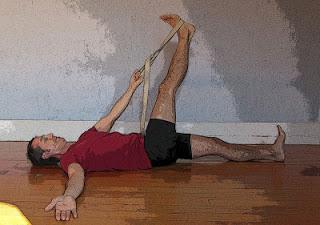 Standing Forward Bend (Uttanasana) with one leg crossed in front of the other can also be helpful.
Standing Forward Bend (Uttanasana) with one leg crossed in front of the other can also be helpful. Opening the Back of the Hip JointTo open the back of the joint, stretching the hamstring stretch muscles by flexing the joint with straight legs is very helpful. Some poses that stretch the hamstrings effectively include Standing Forward Bend (Uttanasana), Reclined Leg Stretch Pose (Supta Padangusthasana) Version 1, and Pyramid pose (Parsvottanasana).
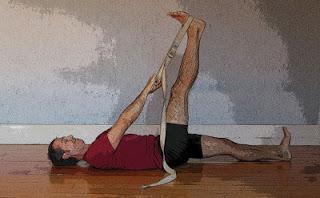 Combinations of MovementsTo address combinations of movements, especially those that include external rotation of the hip joint, which is necessary for poses like Cobbler’s and Lotus poses, Thread the Needle pose is a great way to release tension in the deep external rotators of the hips.If you hold onto the top shin and stretch your bottom leg along the floor, you are essentially doing upside down Pigeon pose without as much potential strain on the knee joint for you folks with knee issues. Sorry I don’t yet have a picture of this variation! In fact, regular Pigeon pose (Kapotasana) is one to avoid for those with knee issues, as it tends to put too much pressure into the front bent knee, especially when doing the forward folding version.
Combinations of MovementsTo address combinations of movements, especially those that include external rotation of the hip joint, which is necessary for poses like Cobbler’s and Lotus poses, Thread the Needle pose is a great way to release tension in the deep external rotators of the hips.If you hold onto the top shin and stretch your bottom leg along the floor, you are essentially doing upside down Pigeon pose without as much potential strain on the knee joint for you folks with knee issues. Sorry I don’t yet have a picture of this variation! In fact, regular Pigeon pose (Kapotasana) is one to avoid for those with knee issues, as it tends to put too much pressure into the front bent knee, especially when doing the forward folding version. You can also get a nice stretch of the posterior gluteal muscles in all your Downward-Facing Dog (Adho Mukha Svanasana) variations, even Half Downward-Facing Dog at the Wall.
 If you then bend your left knee a bit toward the wall and press your hips a bit to the right side of your mat while keeping your right knee straight, you can get a deeper stretch of the lateral gluteal muscles and the deep external rotators of the right hip. And it is easy on the knees! Of course, do it on both sides!Also, the twisting version of Reclined Leg Stretch pose pictured above is also a good one, as are these versions of Marichyasana 3:
If you then bend your left knee a bit toward the wall and press your hips a bit to the right side of your mat while keeping your right knee straight, you can get a deeper stretch of the lateral gluteal muscles and the deep external rotators of the right hip. And it is easy on the knees! Of course, do it on both sides!Also, the twisting version of Reclined Leg Stretch pose pictured above is also a good one, as are these versions of Marichyasana 3: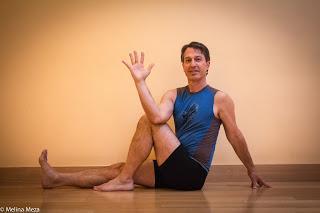
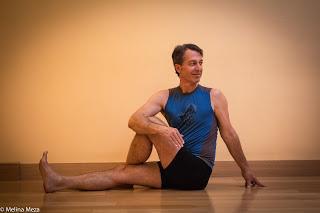 If there is any knee pain when you try this one, you can move your bent knee foot slightly away from the hips. All this should keep you and your students busy for a while!—BaxterSubscribe to Yoga for Healthy Aging by Email ° Follow Yoga for Healthy Aging on Facebook ° Join this site with Google Friend Connect
If there is any knee pain when you try this one, you can move your bent knee foot slightly away from the hips. All this should keep you and your students busy for a while!—BaxterSubscribe to Yoga for Healthy Aging by Email ° Follow Yoga for Healthy Aging on Facebook ° Join this site with Google Friend Connect

